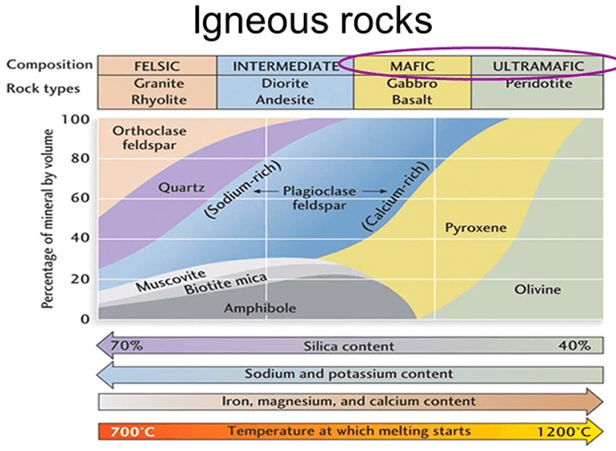Table of Contents
Igneous rocks; those that are formed from molten magma are broadly classified according to their chemical composition using silica, potassium, sodium, calcium, iron and magnesium as the key indicators. Magma is rich in silica, sodium and potassium generally form pale colored feldspar when they crystallize and are termed felsic. They are clustered on the left-hand side of this slide. Magma that is poor in silica but rich in iron magnesium crystallizes dark-colored minerals such as pyro-olivine and pyroxene and the resulting rocks are termed ultramafic these are on the right-hand side of the slide. Magmas with a composition that is between these two end members are classified as intermediate or mafic depending upon their specific composition. In general an element doesn’t actually need to know the details of the chemical composition he can broadly classify igneous rocks by the portions of light and dark minerals. Felsic rocks like granite have few dark minerals, intermediate rocks may have one third dark minerals, mafic.
Igneous rocks are two thirds dark minerals and ultramafic rocks are completed made of dark minerals. In broad terms mafic and ultramafic magmas crystallize at higher temperatures than felsic rocks and are more fluid. The majority of copper nickel massive sulfide and chrome platinum group metal deposits developed in large intrusions that are made up of layers of alternating mafic and ultramafic rock hence the name mafic layered complexes. Being mafic they were intruded at high temperatures and crystallized slowly, relatively deep in the crust.
Characteristics of Igneous Rocks
Rocks formed directly from the rock magma by cooling, either at the earth’s surface, (volcanic rocks) or at some depth in the earth’s crust (plutonic rocks), are called igneous rocks. They are essentially mixtures of some of the following common minerals, quartz, feldspar, mica, hornblende, pyroxene, olivine, etc.; or, if not crystalline, they have a composition that would make one or more of these minerals. Quartz, feldspar, and light-colored mica give the lighter color to acid rocks. Hornblende, pyroxene, and dark mica that is high in iron and magnesia, are classed as ferro-magnesian minerals. They give the dark color to basic rocks.
In color, the igneous rocks vary from light (acid rocks) to dark or nearly black (basic rocks). Being composed of minerals that are hard (except mica), they are mostly hard. In specific gravity, they vary from 2.67 (for granite) to 3.3 (for olivine rocks). The acid rocks are light, and the basic rocks are heavy. In structure, they vary from coarsely crystalline to very fine-grained, or even glassy. When the crystals are large enough to be easily seen, the perfect cleavage of feldspar, the absence of cleavage and glassy appearance of quartz, the softness and thin leaves of mica, the good cleavage and dark color of hornblende and pyroxene, often enable the beginner to name the rock. But in many cases, and especially with fine-grained or badly-weathered rocks, the most experienced man may have to use the petrographical microscope and other laboratory apparatus, before he can name the rock.
The general composition varies with the minerals composing the rock; and as there is almost every mixture of the minerals named above, and, in addition, more or less of accessory minerals, such as tourmaline, epidote, magnetite, etc., no general statement of composition can be made.
Classes of Igneous Rocks
According to percentage of silica, four classes of igneous rocks are distinguished; but it must not be forgotten that one class shades into another. Often only two classes are made: the acid, including acid and intermediate; and basic, including basic and ultrabasic.
- Acid Igneous Rocks—containing above 65% silica.
Examples: granite, rhyolite. - Intermediate Igneous Rocks—containing 50% to 65% silica.
Examples: syenite, trachyte. - Basic Igneous Rocks—containing below 50% silica.
Examples: gabbro, basalt. - Ultrabasic (very basic) Igneous Rocks—containing 35% to 43% silica.
Examples: peridotite, dunite, serpentine.
According to structure and origin, igneous rocks are divided into:
- (a) Plutonic Rocks—distinctly crystalline and therefore coarse-grained.
- (b) Volcanic Rocks—glassy or fine-grained.
An intermediate class may be made, - (c) porphyritic rocks, with larger crystals in a fine-grained or glassy mass.
The crystals in plutonic rocks are crowded together so that they have not taken the regular shapes into which minerals grow when not crowded. They vary in size, so that the rocks have different appearances in grain, some being so fine-grained as to be hard to recognize, others being coarsely-grained and easily “spotted.”
The plutonic rocks have been formed by slow cooling, deep under overlying masses of older rocks. Those that we see at the surface have been uncovered by erosion. Quick cooling at or near the surface formed volcanic rocks.

